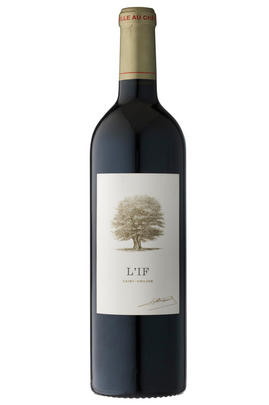
2016 L'If, St Emilion, Bordeaux

Critics reviews
Drink 2024-2041
Antonio Galloni, vinous (Dec 2018)
Drink 2025-2040
Jane Anson, Decanter (Apr 2017)
Drink 2015-2040
Richard Hemming MW, jancisrobinson.com (Nov 2020)
About this WINE

L'If
Located in the St Émilion appellation, which is renowned for its limestone-rich soils, L'If is owned by Jacques Thienpont, the owner of Château Le Pin, another highly esteemed Bordeaux estate. The estate is relatively new, established in 2006, and is situated on a small, 3.5-hectare vineyard.
The vineyard is planted with a mix of Merlot, Cabernet Franc, and Cabernet Sauvignon grapes, with an emphasis on Merlot. L'If follows a traditional winemaking approach, focusing on minimal intervention and allowing the grapes to express their natural characteristics. The grapes are hand-harvested and carefully sorted before fermentation. The wines are aged in French oak barrels, which adds complexity and structure to the final product.
L'If produces a limited range of wines, including a flagship red wine made from a blend of Merlot and Cabernet Franc grapes, typically displaying rich fruit flavours, fine tannins, and a long, lingering finish.

St Émilion
St Émilion is one of Bordeaux's largest producing appellations, producing more wine than Listrac, Moulis, St Estèphe, Pauillac, St Julien and Margaux put together. St Emilion has been producing wine for longer than the Médoc but its lack of accessibility to Bordeaux's port and market-restricted exports to mainland Europe meant the region initially did not enjoy the commercial success that funded the great châteaux of the Left Bank.
St Émilion itself is the prettiest of Bordeaux's wine towns, perched on top of the steep limestone slopes upon which many of the region's finest vineyards are situated. However, more than half of the appellation's vineyards lie on the plain between the town and the Dordogne River on sandy, alluvial soils with a sprinkling of gravel.
Further diversity is added by a small, complex gravel bed to the north-east of the region on the border with Pomerol. Atypically for St Émilion, this allows Cabernet Franc and, to a lesser extent, Cabernet Sauvignon to prosper and defines the personality of the great wines such as Ch. Cheval Blanc.
In the early 1990s there was an explosion of experimentation and evolution, leading to the rise of the garagistes, producers of deeply-concentrated wines made in very small quantities and offered at high prices. The appellation is also surrounded by four satellite appellations, Montagne, Lussac, Puisseguin and St. Georges, which enjoy a family similarity but not the complexity of the best wines.
St Émilion was first officially classified in 1954, and is the most meritocratic classification system in Bordeaux, as it is regularly amended. The most recent revision of the classification was in 2012

Merlot
The most widely planted grape in Bordeaux and a grape that has been on a relentless expansion drive throughout the world in the last decade. Merlot is adaptable to most soils and is relatively simple to cultivate. It is a vigorous naturally high yielding grape that requires savage pruning - over-cropped Merlot-based wines are dilute and bland. It is also vital to pick at optimum ripeness as Merlot can quickly lose its varietal characteristics if harvested overripe.
In St.Emilion and Pomerol it withstands the moist clay rich soils far better than Cabernet grapes, and at it best produces opulently rich, plummy clarets with succulent fruitcake-like nuances. Le Pin, Pétrus and Clinet are examples of hedonistically rich Merlot wines at their very best. It also plays a key supporting role in filling out the middle palate of the Cabernet-dominated wines of the Médoc and Graves.
Merlot is now grown in virtually all wine growing countries and is particularly successful in California, Chile and Northern Italy.


Buying options
Add to wishlist
Description
The 2016 L'If, 100% Merlot in this vintage, is going to need a number of years to be at its very best. The allure the 2016 showed as a young barrel sample has been replaced with huge structure and prominent yet well balanced tannins that both give the wine its strong-voiced personality. Readers should be prepared to be patient with the 2016, as it is going to need a number of years to be at its very best. Even so, the 2016 is super-impressive in the early going, not to mention a fabulous wine in the making. Cyrille Thienpont gave the 2016 14 months in French oak, 50% new.
Drink 2024-2041
Antonio Galloni, vinous (Dec 2018)
wine at a glance
Delivery and quality guarantee